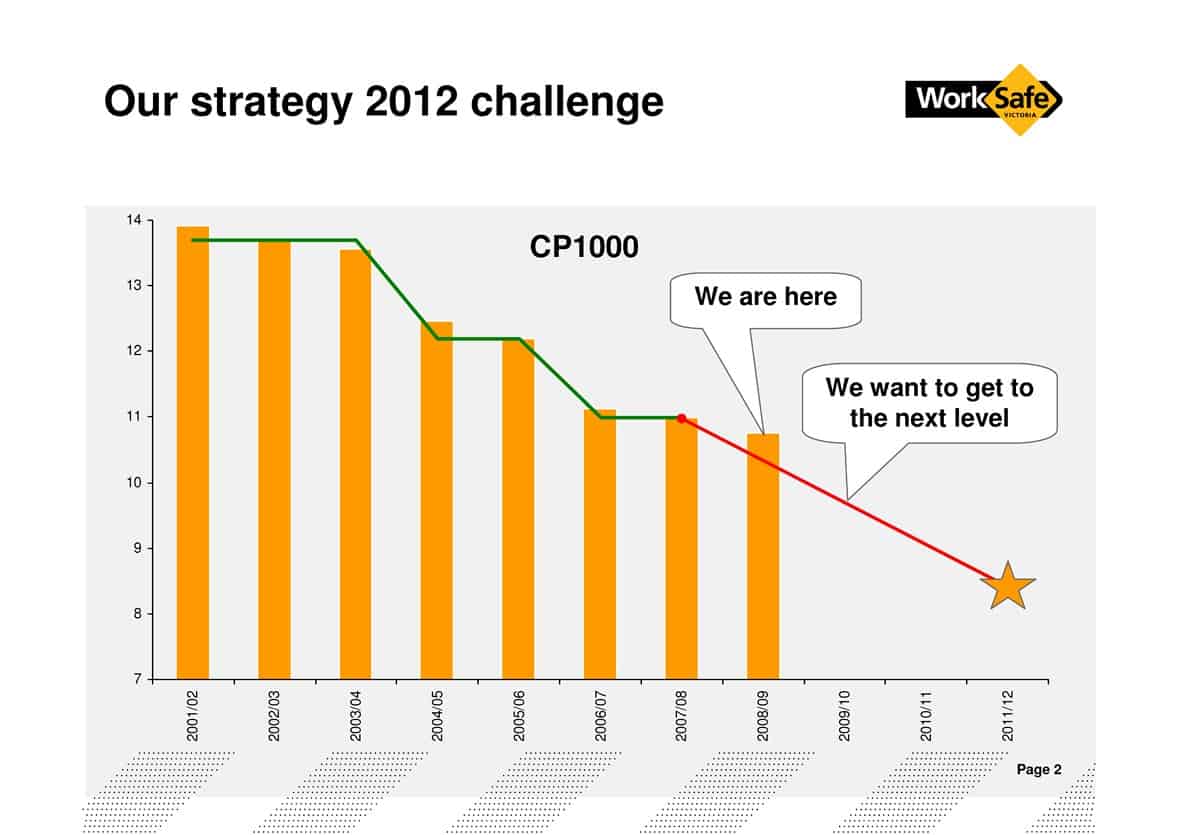On 19 August 2009, the Australian Financial Review (AFR) published an article (not available online) about the lack of success of OHS regulators meeting their agreed performance target. The article is based on the information provided by Safe Work Australia in its 2006-07 progress report.
Below is a chart that WorkSafe’s John Merritt showed at a recent OHS seminar which clearly shows how far the State of Victoria has to go to reach the 2012 target, and it is one of the better performing States.

The Australian Council of Trade Unions (ACTU) has placed its hope for improvement in the upcoming harmonised OHS laws. Jeff Lawrence is quoted in the small AFR article from the ACTU media release:
“Australia has a long way to go before success can be claimed on achieving national targets for workplace death, injury and disease,” Mr Lawrence said. “With proposed uniform national occupational health and safety laws, we have a once-in-a-generation opportunity to lift protections for workers by achieving the world’s best safety standards for the entire country.”
Jeff Lawrence and the ACTU need to remember that harmonised OHS model laws have never been about improving workplace safety. They are about setting the legal framework within which employers and employees improve safety in their workplaces. Safety improvement comes from the management of risk and hazards, not whether it is easier for a union to get onsite or for a company to be more easily prosecuted or for fines to be set at record amounts.
(In fact until recently, Australian lawyers and some OHS lawyers acknowledge that fines do not work for anything other than punishment. Other legal penalty options have been promoted for some time but these seem to have been ejected from the proposed National OHS law.)
The ACTU, and the employer groups, need to start assisting companies to reduce hazards, not only the sites or industry sectors of their own members. Unions are often keen on pushing corporate social responsibility but do not promote safety outside their member organisations. So where is their own corporate social responsibility?
The principal motivator of the union movement in Australia has always been industrial relations, of which OHS is of occasional relevance. Though it is acknowledged that in some specific union sectors, particularly the emergency services and construction, safety has a higher priority than elsewhere.
If the union movement was genuine about improving the lot of Australian workers and of the importance of safety, assisting in the education of business operators, outside their own union sector, to improve safety may show to some workers that being a member of a union may be a good thing.
As has been discussed elsewhere the OHS performance targets of the regulators are purely academic. Former Prime Minister John Howard introduced the concept of “aspirational targets” to the Australian political lingo and the current OHS targets were set during his government. Aspirational targets are those that you sort-of try to reach but if you don’t, it doesn’t matter, as there is no penalty.
If the regulators were genuine about reaching this target, the enforcement of OHS would be substantially different and harsher. The technical assistance for business to improve safety would not rely on the regulators alone or some token business consulting funding. But the targets have no big “stick”, the legislation is in a state of uncertainty, the unions have limited influence, and the community’s awareness of workplace safety is up but still only a trickle on their decision-making radar.
The targets also have no “carrot” other than a media opportunity to say that one State OHS regulator performed better than another, and that will surely create harmony.
No enforcement + no penalty = no effort.



